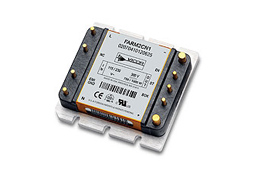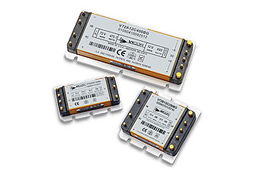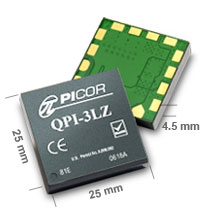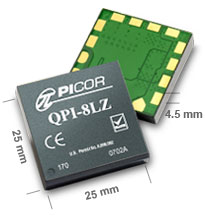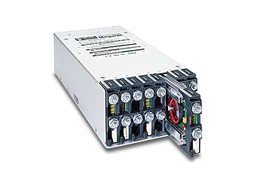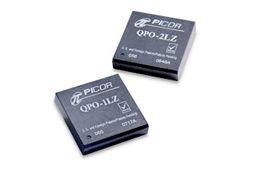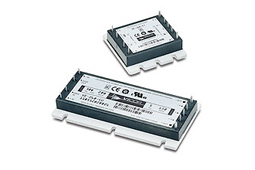Successful Applications
A Fly Away VSAT Global Communications System – Uses a FARM/Mini Power Solution
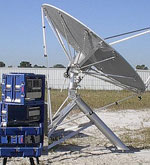
Sputnik, the first man-made earth satellite, was launched on October 4, 1957. With a simple radio transmitter that sent signals to facilitate tracking, it was also the first communication satellite. Satellite communication (satcom) systems, of course, have become much more sophisticated since that time, serving principally as a microwave relay station for such applications as intercontinental telephony, television, radio, Internet, and the military. An interesting satcom application is the VSAT (very small aperture terminal) system used by retail stores and gas stations. When a customer swipes his or her credit card through the card reader at the pump, the data processing center verifies the card, authorizes the transaction, notifies the accounts receivable system, and notes the decrease in inventory (the gas pumped). A variation on VSAT is flyaway VSAT, which is designed to be portable and easy to set up and take down. It’s perfect for news gatherers/broadcasters, emergency/ disaster responders, or military units on the move, even with no experience operating ground satellite terminals.
One manufacturer of flyaway VSAT systems uses a Vicor power solution that is small, lightweight, and rugged. The solution employs a FARM (Filter/Autoranging Rectifier Module) AC front-end module with three Mini converters in parallel to create a 24 V bus. The 24 V bus can be powered by an external 24 V source. The 24 V bus feeds V24B24T200BL and V24B28T200BL converters. Essential for such a widely traveled system, the FARM interfaces directly with worldwide AC mains and, used with Vicor DC-DC converters, realizes an autoranging, high-density, low-profile switching power supply.
Picor Filters Are Providing Smaller, Lighter, High-Performance EMI Solutions for Today’s Military
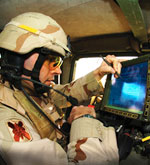
When SCR 300 radios – the famous „walkie-talkie” of World War II – were introduced to combat in 1943, they quickly became ubiquitous. This addition to the less mobile field telephone made it possible for every unit from platoon to division to communicate reliably with one another and with forces on sea and in the air. Before then, battlefield communications were often limited to runners between units and signals – such as flares, bells, whistles, trumpets, and other visual and aural signals – to communicate or acquire information. Today’s military communications capabilities have expanded to enable the transmission of voice, data, and video information in bad weather or good, day or night wherever it’s needed.
As a practical matter, military systems – HF modems, transmitters, power amplifiers, man-pack/vehicular radios – need smaller, lighter, high performance EMI solutions. Power converters typically have 24/28 V inputs with a wide variety of power ranges, often with redundant feeds. These devices usually require a wide input operating range, and having a filter that can operate within that range is important. Picor filters are compatible with wide-input- range converters and can support up to 14 A at a 10 V low line, depending on the QPI model.
Military power systems are now moving toward distributed power 1 , so board-level filtering is growing in popularity. With only a few packaged solutions competing in the space, the Picor solution is positioned to win lots of sockets.
1 Military DC-DC Converters Eye Distributed Power – COTS Journal, October 2004
Products used:
Vicor’s VI Brick PRM/VTM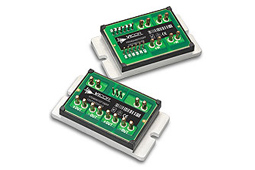
A Vicor Custom Power Supply is the Cure for an Industrial LED Application
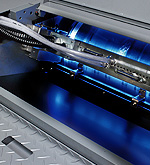
Light-emitting diodes (LED), an electronic light source, were invented in Russia more than 80 years ago. All early devices emitted low-intensity red light, but modern LEDs are available across the visible, ultraviolet, and infrared wavelengths, with very high brightness. In recent years, LEDs have been appearing with increasing frequency as low-energy indicators but also for replacements for traditional light sources in general lighting. Applications of LEDs, however, are diverse. Their compact size has allowed new text and video displays and sensors to be developed, while their high switching rates are useful in communications technology. Infrared LEDs are often used in remote controls for TVs and VCRs. Grow lights use LEDs. Ultraviolet (UV) LEDs are used for sterilization.
UV LEDs are even used as curing devices for some ink and coating applications. A Vicor custom power supply, in fact, is used to power UV curing lamps for industrial applications. The largest part of the industrial market is in printing, and almost all use UV mercury lamps now. LED technology is poised to replace UV mercury lamps with this cleaner, cheaper, lower power, and more environmentally friendly alternative.
LEDs require a constant current for proper operation. The Vicor custom power solution employed VI-BRICK PRMs, which are very efficient non-isolated regulators, to provide a highly regulated distribution voltage for powering downstream VI BRICK VTMs. In addition to the cost-effective solution, the compact form factor offered by the Vicor power solution is a key advantage for us.
VoIP Media Switching System Uses – Picor Active EMI Filters
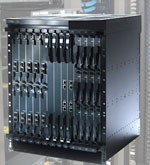
Voice over Internet Protocol (VoIP) is essentially telephone service accomplished over the Internet. The significant benefits that VoIP can offer include lower cost and greater flexibility than plain old telephone service (POTS). VoIP reduces communication and infrastructure cost by using existing data networks and by not charging for features such as caller ID and call forwarding. That VoIP is billed by the amount of information transmitted and not by time connected reduces the cost even more. Flexibility is improved by being able to transmit more than one call at a time, providing location independence, and offering integration with other services available over the Internet.
A number of methods are available, but a VoIP media switching system can provide carrier-class VoIP for residential distribution. The ability to support large numbers of subscribers with a single platform is key, and systems such as this can support anywhere from 5,000 to 100,000 subscribers. Supporting this many lines requires higher power levels than most other categories of telecommunication systems.
An application such as this could require –48 V (-40 to –60 V) input, approximately 360 W per board and up to 9 A current capability (potentially more for short intervals). In normal operation, the ability to choose between 7 A or 14 A QPI input filter, both in the same form factor, is an attractive advantage. At these power levels, the QPI is less than half the size of competitive passive filters.
Vicor Minis Drive a Mobility Platform
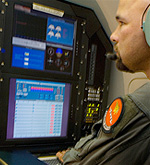
It’s not „plastics” anymore. The latest buzzword is two words: „mobility platform.” They’ve been applied to robots, cell phones, pagers, PCs – palm, pocket, laptop – and even to wheelchairs. Nevertheless, it has serious meaning for those in the military, the public safety sector, and even for enterprises such as commercial fishing. Wherever real-time voice, video, and data communications are needed, it’s important that a rugged, reliable, and portable system be available to provide it.
Our customer produces rugged, waterproof, integrated PC-based mobility platforms for a number of Special Forces. The underlying function of these platforms is to provide the elements of C 4 ISR (Command, Control, Communications, Computers, Intelligence, Surveillance, Reconnaissance) to the user. One system, for example, has two major elements: (1) a command and control user interface containing computing platforms and application software to manage data, video, radio, and power, and (2) a power distribution and management system.
Element (2) contains the unit with Vicor modules. Each of four wide-input-range Vicor DC-DC converters from the 24 V input (18 V to 36 V) Mini family deliver 36 V at 200 W to the power distribution module in a tactical system integration network. The application benefits, of course, from the low-noise ZCS/ZVS (Zero Current Switching/Zero Voltage Switching) architecture and fully encapsulated modules. A proprietary spin fill process ensures complete, void free encapsulation making them suitable for the most harsh environments.
For this application, however, the most important reasons for the choice of Vicor modules were their small size and high power density.
Integrated Picor Filter and Hot-Swap – Save Space and Reduce Complexity of a Passive Optical Network

Fiber optics is a technology used to transmit digital signals ― such as television, internet data, and voice ― over longer distances, with less loss, and at higher data rates than other communication systems. A passive optical network (PON) is a fiber optics network architecture that uses a single optical fiber to serve multiple end users.
Our customer is a telecom company that designs and develops PON access equipment. Their unique technology has led to the development of a new hybrid RF PON system that allows for seamless bridging of traditional telephone service, Ethernet, and video services over a PON system. Fiber systems such as this 10 Gigabit PON offer high volume „last mile” bandwidth allowing users combine voice, video and data with flexibility to support TDM or IP voice, RF or IP video and ultra high speed data. Achieving this requires the ability to combine lots of computing and I/Os into a relatively small space.
The power is -48 V (-42 to -65 V) input, hot-swap enabled, redundant feed, with about 500 W of total system power (less than 200 W per card) It is NEBS (Network Equipment Building System) compliant. That means it meets NEBS technical requirements to ensure network integrity. The QPI-8, which integrates a total hot-swap function with an active EMI filter, aligns with the AdvancedTCA PICMG® requirements for hot insertion and board level conducted noise limitations. Combining the filter with hot-swap helps save valuable board area and simplifies the design.
Pole-Mounted Cell Tower Chassis – Powered by PFC MegaPAC

Telecommunications, which replaced the word telephony, means much more than the original. The American Heritage Science Dictionary defines telecommunications as „sending and receiving information such as sound, visual images, or computer data over long distances through the use of electrical, radio, or light signals, using electronic devices to encode the information as signals and to decode the signals as information.” It certainly includes the telephone, both fixed and mobile; television, whether distributed by broadcast, coaxial cable, or fiber optic cable; and, of course, the Internet. The analog telephone coexists with the digital telephone, and the analog television was recently superseded by the digital telephone. Some companies offer all-digital telephones, television service, and, of course, the Internet. All of this is supported by a complex infrastructure, increasingly interrelated, some of it even shared by competitors.
One of the builders of telecommunications infrastructure is a Vicor customer. They are a turnkey telecommunication construction contractor that builds cell/microcell sites, installs fiber optic and coaxial cables, engineers and constructs pole-mounted power supplies, among other infrastructure projects. A cell tower chassis that they built required power conversion. The chassis – with dimensions of 42 by 28 by 10.5 inches – was designed to be mounted on a streetlight pole and contained the remote radio head, a site control and monitoring unit, and a Vicor PFC MegaPAC.
This high-power application (1250 W) required that power be taken from the power line and provide three DC voltages (25, -5, +5 V) with minimal ripple and noise. The PFC MegaPAC, an off-line power-factor-corrected AC-DC switcher, provides 1600 W and meets the conducted EMI requirements of FCC class A and EN55022.
Picor Filters Offer Easier EMI Compatibility with Integrated Ground and Unmanned Aerial Vehicle Systems
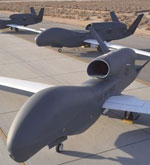
Unmanned aerial vehicles (UAV) have been used in military applications since WWII (for training antiaircraft gunners), and, in Vietnam, they were used for reconnaissance and data collection. In recent years, the use of UAVs for many more military roles – for reconnaissance, as targets and decoys, and for remote sensing, transport, scientific research, search and rescue – is showing spectacular growth. One very significant potential UAV application – to date, relatively unexploited – is communications. The UK’s Bowman Battlefield Communication System, for one example, provides command and control and battle management, integrating digital voice and data technology to provide secure radio, telephone and tactical Internet. Bowman, which involved the conversion of over 18,000 platforms and cost in excess of £2 billion, has been in operation in Iraq since 2005. The use of a UAV as a high-altitude platform (HAP) could enhance the range and value of tactical communication services and capabilities that systems like Bowman can offer.
Power systems for such a variety of integrated in-field and in-flight systems need to deliver EMI compatibility as well. Meeting these requirements may begin with the use of off-the-shelf components along with some aditional circuitry, but starting with a high-performance filter minimizes the additional work. Picor 24/28 V QPI input filters and QPO output filters provide EMI performance and are, with their small size and weight, compatible with UAV in-flight requirements as well as the needs of troops in the field.
Picor Filters Attenuate Noise in Chinese 3G and 4G Wireless Networks
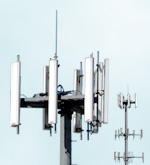
Picor active filters (QPI series) are designed into the power systems of several large Chinese telecom OEMs that design TD-SCDMA (Time Division-Synchronous Code Division Multiple Access) systems, a channel access method adopted by China for its own national wireless networks. TD-SCDMA is very similar to ATCA (Advanced Telecommunications Computing Architecture), in the regards to specifying such parameters as the power limit, EMI limits, and fault tolerance on a per board basis. Next generation (4G) networks achieve greater capacity through improved spectral efficiency.
Picor active filters are designed into multiple unique board TD-SCDMA designs, each using a different „industry standard” DC-DC converter. The mixed use of different converters typically makes the EMI and hot-swap design more challenging for passive designs. Picor active filters are universal in nature and are compatible with most industry standard converters and can therefore simplify the overall design effort. In TD-SCDMA systems each board typically has a requirement for hot-swap capability, a 48/12 V DC-DC converter and a need to achieve Class B EMI filtering. Power levels for TD-SCMA (3G) range anywhere from 70 to 150 W per board and the overall system has up to 40 boards per node. For 4G systems where more power may be needed, Picor QPI filters can support up to 14A in the same 25mm x 25mm SiP package size. Much like ATCA, the distributed power design of TD-SCDMA provides higher reliability, which comes however at the expense of PC board real estate. QPI models with integrated hot-swap save space from the filter perspective, and provide further space savings by integrating the hot-swap function. The QPI solutions can also address a broad range of other wireless telecom infrastructure platforms that are being adopted elsewhere around the world.
Classic Bricks Play a New Role: Wireless Telecom
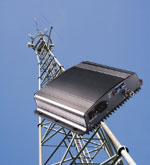
The wireless telecommunications industry uses a cellular repeater (esentially a reception antenna, a signal amplifier and an internal rebroadcast antenna) to boost cell phone reception to the local area. Analogous to the cellular broadcast towers used by the network providers, they are much smaller, usually intended for use in one building. The systems usually use an external, directional antenna to collect the best cellular signal. The signal is then transmitted to an amplifier and then retransmitted locally, providing significantly improved signal strength. The more advanced models often also allow multiple cell phones to use the same repeater at the same time, so they are suitable for commercial as well as home use.
Our Vicor customer specializes in the development of high-quality active and passive indoor wireless products. With a complete line that includes bi-directional amplifiers, repeaters, in-line boosters, and system components, their products have been used to extend wireless coverage to virtually any indoor space. The subject application uses the PCS (Personal Communications Service) band, which is the 1900 MHz radio band used for digital mobile phone services in North America. CDMA (Code Division Multiple Access) and GSM (Global System for Mobile communications) systems can be used on PCS frequencies.
The design consists of two parts, the amplifier box and the control box. They use a VI-200 brick (72 Vin to 12 Vout) in the amplifier box, and two VI-J00s (12 Vin to 5 Vout and
12 Vin to 28 Vout) in the control box.

